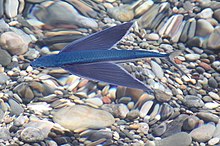|
Atherinomorpha
 The Atherinomorpha is a clade of fishes in the superorder Acanthopterygii, the ray-finned fishes, consisting of three orders. The clade is ranked as an infraseries within the subseries Ovalentaria, which in turn is ranked within the wider Percomorpha clade. CharacteristicsThe species within the infraseries Atherinomorpha are generally small fishes which normally grow no longer than 2–10 centimetres (0.79–3.94 in), although some needlefishes from the order Beloniformes can grow as long as 2 metres (6.6 ft). The testes of the males are of the restricted spermatogonial type, in which the testes change to reflect a seasonal pattern of reproduction.[1] The females lay demersal eggs with filaments on the chorion. They may or may not have spines in their fins but where these are present they are generally weak. The number of vertebrae is normally less than 24. The pelvic fins are positioned abdominally, subabdominally, or thoracically and may be connected to the pleural rib by a ligament. Ctenoid scales may be present but this is rare within this grouping.[2] The majority of the species within the Atherinomorpha are surface feeding fishes, and about three quarters of the species are restricted to fresh or brackish waters. Within this infraseries adaptation to internal fertilisation has been independently evolved, especially in freshwater groupings, and this taxon contains a greater diversity of internal fertilization than any other group of fishes. Species may be oviparous or viviparous. The filaments on the chorion are used to stick to the substrate and in most taxa, other than the exocoetoids there is an obvious droplet of oil that forms at the vegetal pole.[3]  TaxonomyThere is very strong evidence that the Atherinomorpha forms a monophyletic grouping, supported by the emphasis of diverse and unusual reproductive adaptations and this has subsequently been supported by molecular studies. Within the group the Atheriniformes are a sister group to the Beloniformes and the Cyprinodontiformes, with the atherinids which have spines in their fins being regarded as the most basal members of the clade.[3] The fossil range of the Atherinomorpha is the Eocene to the present.[2] The Atherinomorpha is classified as follows:[3]
References
|
||||||||||||||||||||||||
